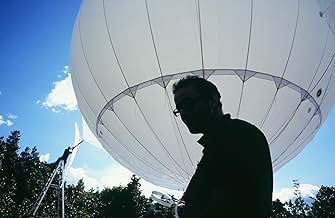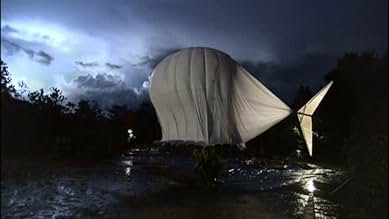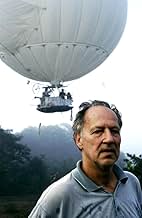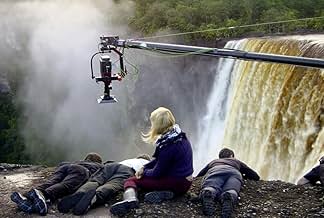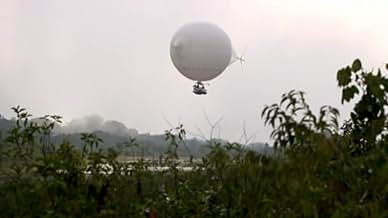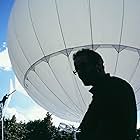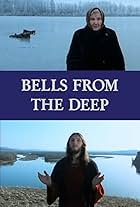Engineers attempt daring journey above Guyanese rainforest canopy with airship prototype. Adventure fraught with risks, as previous expedition ended tragically. This is a unique story of exp... Read allEngineers attempt daring journey above Guyanese rainforest canopy with airship prototype. Adventure fraught with risks, as previous expedition ended tragically. This is a unique story of exploring uncharted jungle from the air.Engineers attempt daring journey above Guyanese rainforest canopy with airship prototype. Adventure fraught with risks, as previous expedition ended tragically. This is a unique story of exploring uncharted jungle from the air.
- Awards
- 2 wins & 2 nominations total
- Self
- (as Dr. Graham Dorrington)
- Self
- (archive footage)
- (as Götz Dieter Plage)
- Self
- (archive footage)
- Self
- (as Dr. Michael Wilk)
Featured reviews
More than his fiction films I am a fan of Herzog's documentaries. There is something about the way he sees a subject that opens your eyes to things other than the subject at hand. Often his documentaries are almost something else, his Lessons in the Darkness about the oil well fires in Kuwait is structured as an aliens arrival on earth. Its a haunting film that is more magical and informative than the similar IMAX film Fires of Kuwait.
The White Diamond, is on the face of it the story of the building of an airship to study the canopy of the rain forests. It is also, as Werner Herzog tells it, the story of the search for absolution for the death of the inventors friend. I will certainly buy the first part, but I highly doubt the second.
This is simply one of the most beautiful films I've ever seen. The shots of the balloon in flight, the waterfall, the birds that live by the falls and the life in the canopy make this the first time I ever wanted to own the biggest and best TV ever made just so I could see these images. I doubt that other than on a rare occasion you'll ever have seen anything as beautiful.
Herzog also introduces us to some real characters Dr Dorrington, the inventor of the airship is a man of great passion. Mark Anthony Yhap, a man hired to help porter materials is probably worthy a film himself. Also the rest of the crew are also intriguing characters for the brief period they cross the screen. It is the mix of people and image that make this film work as well as it does.
The trouble is that the film almost doesn't work. As a narrative the film is sloppy and unfocused. We are told about the cave behind the falls where the birds live and where no one has ever gone.We see a camera lowered down to a climber so footage inside the cave can be shot, only to be told we will not be shown the footage. It is only sometime later that we are told why, what is in the cave is a legend and to reveal whats there could up set the belief of the population. Its an odd way round the subject and feels completely backwards. The real trouble with the film is the way Herzog hammers away at Dorrington about the death of a friend some years earlier when a ship he had made got caught up in the trees. Dorrington was in no way responsible for the accident of the death (other than he built the ship that was involved) but Herzog trumpets the point over and over in order to give some dramatic tension to what appeared to be a pretty straight forward test flight of the airship. It adds a false note that almost sinks the film...from which it recovers from when ever we see the ship in flight or get away from the morbid subject.
Definitely worth seeing. Its a flawed masterpiece that's a must in High Definition or on a really good TV.
Dorrington has been fascinated with flight since he was a boy messing with rockets (and losing a couple fingers in the process). To soar weightless over the earth is for Dorrington literally a dream; he sees himself floating over cities in his sleep. He seeks to realize his dream in a specially designed airship, a pygmy blimp shaped like a giant ball with a conical tail, a flimsy frame gondola dangling below it. Not content with flying the ship over the dull English countryside, Dorrington journeys with it to Guyana, intending to guide it over the unexplored jungle canopy. His quest, which seems only mildly insane (compared to activities detailed in other Werner Herzog films), is lent extra urgency by his guilt over the death of a colleague, the jungle cinematographer Dieter Plage, who crashed a vehicle similar to Dorrington's White Diamond (its name comes from its resemblance to the gem) during an earlier expedition.
Werner Herzog has tackled characters like Dorrington before, in both fiction (Fitzcarraldo) and non-fiction (Little Dieter Needs to Fly) films. What seems to fascinate Herzog is the single-mindedness of these men, their willingness to dare destruction in the name of achieving some goal whose significance is apparent only to them. Herzog relates to these men, because he himself is a man given to folly; the quest of Fitzcarraldo, to bring opera to the Amazon via riverboat, is scarcely less mad, less potentially disastrous, than Herzog's own quest to film the story as realistically as possible (real jungle, real riverboat). Not content to merely record the craziness of others, Herzog seems motivated to join in it. The jungle provides a perfect proving ground for people like Herzog and Dorrington; the everyday world doesn't have the right dimensions, the right sprawling spaces, the right sense of teeming, hostile life, to match these men's expansive visions. Herzog, no longer the mad genius of Aguirre, the Wrath of God (the jungle is no longer a surrealistic hell for Herzog, but a place of spiritual majesty), has honed his craft to a fine edge. He tells his story efficiently, paints his portrait of Dorrington precisely, revealing the guilt beneath his gentle eccentricity. Dorrington is the sort of man who always seems to be looking somewhere else; his mind seems always on the verge of wandering into some kind of reverie. But it's not only his dream of flight that distracts him; he's haunted by his perceived culpability in the death of Dieter, and seems driven by the need for atonement.
Herzog's aim in The White Diamond is to correlate the random, incomprehensible beauty of the jungle with the randomness and mystery of human obsession. The airship experiment is carried out near a giant waterfall called Kaieteur (it's four times higher than Niagara Falls), and in a cave behind the falls roost up to a million swifts, which Herzog films soaring and swirling through the air, and swooping in endless streams into the unexplored void behind the watery curtain of the falls. A climber endeavors to film the cave beyond the falls at one point, but his footage has been left out of the film at the behest of the natives, who believe that to reveal the truth of the cave, which they hold to be filled with mythic monsters, would be to destroy some essential part of their culture. The eternally hidden cave becomes a metaphor for that which is unknowable, not only in Nature but in the human heart, and specifically in men like Dorrington, who, like the swifts as they dance and dart through the air, and plummet into the darkness of their cave, are driven by impulses no one else can understand, an inner-music no one else can hear. There's a whiff of New Age jive to all this, as there is in much of Herzog's work, but what the film may lack in philosophical weight it makes up for in pure imagist excitement. Even working in DV, which doesn't make for the kind of haunting effects film can achieve, Herzog manages to evoke the wonder, the peril, the profound mystery of the jungle. The sky may call to Dorrington, but the jungle has always called to Herzog, and in The White Diamond the two obsessions merge to form something joyous, inscrutable and lurkingly dangerous.
Like other Herzog films I have seen recently, there are moments of involving action pitting man against nature, along with stretches of dullness and sudden outbursts of enormous beauty. Just to watch the flocks of swifts fly in formation above Kaieteur Falls, a waterfall four times the height of Niagara, backed by the cello of Ernst Reijseger and the chorus of the Tenore E Cuncordu De Orosei, is an experience in itself worth the price of admission.
The film begins with a brief overview of the history of flight including scenes of the horrific crash of the Hindenburg Zeppelin in Lakehurst, New Jersey in 1937, a tragedy that ended the dream of travel in lighter than air vehicles. The film then shifts to Guyana where Dorrington is in the process of assembling a two-person airship to help him make his journey and confront his past demons. Dieter is a thoughtful man though given to childlike outbursts of enthusiasm. He dreams of "drifting with the motors off in the peace and quiet, quietly floating above these forests in the mist". Though Herzog seems to want to portray all his protagonists as slightly mad, Dorrington appears too grounded to fulfill the director's wishes. His purpose contains elements of both inner and outer exploration. He wants to move on from a tragic accident that occurred eleven years ago when his friend and companion Dieter Plage was killed while flying one of his airships.
Dorrington is reluctant at first to discuss Dieter and his tragic end, but later recounts in agonizing detail the precise details of the accident for which he blames himself. In a scene later revealed to have been staged, Herzog and Graham argue about whether cameras should be allowed on the test flight of his airship christened The White Diamond by a local miner, but Herzog prevails because he fears that it may be the only flight that will take place. We sense throughout the early part of the film that any flight is dangerous and extreme precautions are taken to ensure safety. There are other peripheral characters that we have come to expect from Herzog.
A young cook does a Michael Jackson dance to hip hop music while standing on the edge of a cliff and we meet Mark Anthony Yhap, a diamond miner whose eloquent philosophy contrasts sharply with the more inner-directed Dorrington and he waxes poetic when talking about his beloved rooster. Yhap is a Rastafarian, an African religion that believes that Haile Sellassie is the living God. Yhap wants to fly so that he can visit his family in Spain whom he hasn't seen in many years and his contact information appears in the credits. All this is peripheral to the main event, however, and as we soar over the rain forest, we forget Herzog's description of nature as "a brutal place full of murder and cruel indifference" and simply bathe in its majesty.
Storyline
Did you know
- TriviaCandy Claws created an alternative soundtrack to this film, "Two Airships."
- Quotes
Marc Anthony Yhap: That is a beautiful view. It has a sunset and there is the balloon just floating around aimlessly. Yeah, it's beautiful. It's just fantastic. I'm so fortunate enough to witness something of a gem. I'm a miner mostly, and this is like a diamond. Nice big diamond. Yeah, I love this. This is cool. This is real cool. There is this big white diamond just floating around in the sunrise. It's good.
- ConnectionsFeatured in Was ich bin sind meine Filme - Teil 2... nach 30 Jahren (2010)
- How long is The White Diamond?Powered by Alexa
Details
Box office
- Budget
- €1,000,000 (estimated)
- Runtime1 hour 28 minutes
- Color
- Aspect ratio
- 1.78 : 1
Contribute to this page


